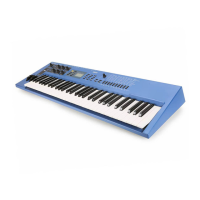36
AMPLE:
Drum Pitch Coarse
Key E1 (Analog Snare H):
Control 099 024
Control 098 040
Control 006 066
Control 099 calls up drum parameter PITCH COARSE,
Control 098 sets the NOTE NUMBER (40 = E1) and Control
006 increases the sound‘s initial pitch by two semi-tones,
resulting in the snare‘s higher tuning.
Let‘s stick with this example for a moment. Imagine you are
working on a snare fill and decide that the snare should
increase by a semi-tone with each beat during the fill. All you
need to do is insert Controller 006 with the required value.
Don‘t forget to reset the snare‘s pitch after the final beat to
its initial value (e.g. 66), as the rest of the song will otherwise
sound a little strange.
Should the fancy take you to experiment some more with
the snare, try controlling the DRUM DECAY RATE with
NRPN. A value of between 80 and 100 will lend a punchy
percussive edge to your snare! By the way, both Decay 1 and
Decay 2 are controlled simultaneously this way.
AMPLE:
Drum Decay Rate
Key E1 (Analog Snare H):
Control 099 023
Control 098 040
Control 006 096
As you can see from these examples, NRPN can be used
effectively and is often well worth the effort. At the same
time the XG concept‘s ability to perform as far as real-time
sound parameter control is concerned is hereby proven
beyond a doubt.
We should also take a quick look at RPN messages and
their applications. These messages can control three param-
eters (see below):
Table: RPN Parameter
A peculiarity of RPN messages is that they require Control-
lers 100 and 101 to be set to 0. Strangely, this is actually
done with 127.
Parameter Cntr 101
(MSB)
hexadecimal
Cntr 100 (LSB)
hexadecimal
Cntr101
(MSB)
decimal
Cntr 100
(LSB)
decimal
Pitch Bend
Sensitivity
00H 00H 0 0
Fine Tune 00H 01H 0 1
Coarse Tune 00H 02H 0 2

